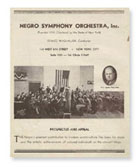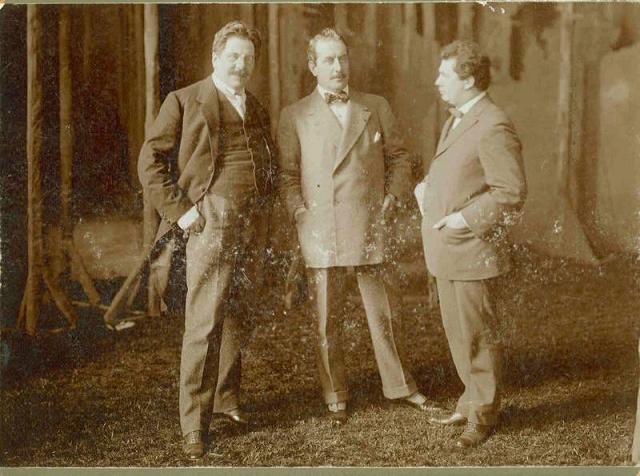Preserving the Legacy of My Grandfather, Ignatz Waghalter
By David Waghalter Green

Ignatz Waghalter, born in Warsaw in 1881 as the fifteenth of twenty children, grew up in a family of musicians. His great-grandfather, Laibisch Waghalter (1790–1868), was referred to in his time as the “Paganini of the East.” Both Ignatz’s father and mother were musicians. Among the many siblings of Ignatz (only seven of the twenty survived childhood), four children became prominent musicians. When the Nazis published their notorious Index of forbidden Jewish musicians in 1943, no less than six Waghalters were listed, including, besides Ignatz, my great-grandfather Abraham, two great-uncles Henryk and Wladyslaw, a first cousin Yolanda, and my mother Beatrice.
Ignatz Waghalter died in New York City on April 7, 1949 almost exactly nine months to the day before I was born. My mother told me that when she saw my grandfather the day before he died—suddenly and unexpectedly of a massive heart attack—his last words to her were: “And when will I have a grandson?”

Despite his death, my grandfather somehow remained a strong presence in our family. He was referred to always as “Opi” (German for Grandfather). His widow—my grandmother Toni (1885–1964)—lived with us in our home in Kew Gardens, New York. I was very close to her. I called her “Omi,” after the German “Omama.” I was from an early age entranced by the stories of her life with Ignatz, with whom she lived for 46 years. Her imperious personality seemed to combine elements of Cosima Wagner and Alma Mahler. She would speak of Ignatz’s career in Berlin as a conductor at the Deutsche Opernhaus between1912 and 1923. Omi would recall how Puccini flirted with her when he came to Berlin in 1913 for the German premiere of The Girl of the Golden West, which Ignatz conducted. She told intensely human and often humorous stories about the famed musicians and personalities who visited the Waghalter apartment in Charlottenburg—singers like Slezak, Laubenthal, and Tauber; writers like Siegfried Jacobssohn and Stefan Zweig; and even a physicist who loved to play the violin by the name of Albert Einstein.
Omi told me of Ignatz’ many struggles in Berlin, even at the height of his career. He was not only a Jew. He was a Polish Jew, leading one of the most important German cultural institutions! Waghalter was not in the least religious, at least in any conventional sense. He never attended religious services. But he was uncompromisingly obstinate in his refusal to convert for the sake of his career, as so many other Jewish musicians of the time (such as Gustav Mahler, Bruno Walter, Leo Blech and Otto Klemperer) did. Waghalter felt a deep loyalty to the traditions of his family, and he would not consider renouncing these traditions for the sake of his career. He condemned no one for their own private decisions, but his own stand incurred no small amount of hostility.
My grandmother, though aged, still possessed a lovely mezzo-Soprano voice (she had met my grandfather in 1902 while studying voice in Berlin). She would occasionally sing selections from his operas and songs. And from time to time she would urge me to go into the attic of the house and look for music that was stored in a large black trunk that had been brought over from Europe.
My grandmother died in November 1964 at the age of 79. In 1972 my parents sold the house in Kew Gardens and moved into Manhattan.
Most of what I knew of my grandfather’s music was based on what I heard my mother play on the piano. She, too, was immensely gifted as a musician. After the Nazis came to power in 1933, Beatrice worked within the Jewish Cultural Bund, giving performances to Jewish audiences throughout the country. Her last concert in Hamburg, shortly before she fled Germany in late 1937, was attended by 2,000 people. Beatrice had perfect pitch and could reproduce on the piano any music that she had ever heard. Beatrice had loved her father deeply, and improvised selections from his work that remained in her memory. There was one piece, in particular, that she delighted in playing. It was a lovely piece for the piano, entitled “Beatrice.” She told me that her father had composed that work after she, as an infant, had smiled for the first time.

I had little direct knowledge of Ignatz’s larger compositions—his operas and various orchestral works. But I knew of these compositions, having read through several volumes of press clippings—dated between 1910 and 1925—that contained many reviews of his major operas. Jugend, for example¸ was acclaimed by the Berlin public and was the most popular of all operas that received their premiere at the Deutsche Opernhaus during the first decade of its existence. Was it not possible, I asked my mother, for these works to be revived? Beatrice saw little possibility for that to come about. Her father’s music was too melodic and lyrical. He did not experiment with atonalism. She would offer these judgments with sadness and a degree of resignation. Beatrice had witnessed her father’s decline into artistic oblivion, and it was for her a very painful subject. She recalled walking with Ignatz along Central Park West in New York sometime in the 1940s. He suddenly stopped, pulled out the insides of his empty pockets, and asked: “All the talent in the world, and what have I to show for it?” The years in New York had been difficult and painful. My grandfather attempted to form a “Negro Orchestra”—the first of its kind. It won tremendous support among Harlem musicians and even received the backing of several radical unions. My mother recalled how Ignatz walked through Harlem with a 6 foot 5 inch African-American trumpet player—nicknamed “Tiny”—in an attempt to recruit musicians. My grandfather rehearsed with them in a YMCA building and in his own apartment. Finally, a concert was organized and it was immensely successful. But residents in the Central Park West apartment building had gathered signatures on a petition, demanding that my grandfather stop inviting African American musicians to his home or face eviction. Funding for the project dried up, and the Negro Symphony Orchestra could not be maintained. These memories weighed upon my mother, and she remained deeply skeptical—despite my appeals—about a revival of his music.

One afternoon in 1988, while visiting her apartment in Manhattan, I asked my mother where she had stored the trunk with all of “Opi’s” music. I was stunned by her answer. She had not taken the trunk with her. It had been left behind in Kew Gardens. The very next day, I went out to Kew Gardens to visit my old home on Abingdon Road. The house was up for sale, but the family that had purchased it back in 1972 was still in possession. After introducing myself and explaining my mission, I asked the owner if she would allow me to look in the attic to see if the trunk was still there. The permission was granted and I mounted the stairs up to the third floor attic. I recalled a small crawl space in which the trunk had been stored. I made my way into it, and there I found the old black trunk. I unfastened the large brass buckles and opened it up. Lying within it were countless old manuscripts, scores, handwritten notations—the remains of what had been a life devoted to music. I felt as Dumas’ hero must have felt when he discovered the treasure on the Island of Monte Cristo! With the house owner’s permission, I removed the trunk, summoned a taxi, and took the music back to Manhattan. Later I brought all the material back with me to my home in Detroit.
Just one year later, in 1989, my mother was informed that the Deutsche Oper in Berlin planned to perform excerpts from Waghalter’s 1917 opera, Jugend. We traveled to Berlin for the occasion. For the first time I had an opportunity to hear portions of a major work. Though it was performed with only piano accompaniment, I was struck by the opera’s extraordinary beauty. This convinced me that Waghalter’s music deserved to be revived. In the years that followed I wrote countless letters to musicians, artists and critics, attempting to revive interest in Waghalter’s legacy. In the late 1990s, after a lengthy correspondence with Stanley Sadie, an entry for Waghalter was included in the new edition of the Grove Musical Encyclopedia. The decision was made after Mr. Sadie reviewed some of the documentary material in my possession related to Waghalter’s career. He expressed amazement that a musician of Waghalter’s stature been so completely forgotten.
Following my mother’s death at the age of 87 in 2001, I established a Waghalter web site, filling it as best I could with documents, photos and music. It also contained contact information, for those who might be interested in the music of Ignatz Waghalter. Many years later, in 2009, I received an e-mail from the young violinist Irmina Trynkos, asking me whether I had access to the violin concerto of Ignatz Waghalter. Yes, I certainly did.
I met Irmina in London. With her own fiery Polish temperament—probably similar to that of my grandfather—Irmina struck me as an artist ideally suited to bring Waghalter’s music back to life. Not long after, I was introduced by Irmina to another brilliant musician, Alexander Walker. He had undertaken the task of conducting the Violin Concerto and the Rhapsody for Violin and Orchestra. Both these works were among those that had languished silently for so many decades within the black trunk in the attic on Abingdon Road.
Of course, I am personally attached to the Waghalter story. I understand that an authoritative appraisal of Waghalter’s music must be made by audiences and professional critics. But I believe that the tragedy of Waghalter’s life and the fate of his music provide an insight into the catastrophic experiences of his time and its impact upon all of human culture. In recovering Waghalter’s music, we are recovering a portion of what was lost as a result of the fascist barbarism that descended over Europe in the 1930s.
In his autobiography, Out of the Ghetto and Into Freedom, written in 1936, Waghalter wondered what awaited him. The Nazis had hounded him out of Germany. He was stateless and penniless. “And so I am forced again onto the path of a difficult struggle for existence,” he wrote in the book’s closing paragraph. “But to where? Perhaps to the land of Israel…or to the eternally young North America? But wherever it may be, I am determined to serve the cause of Art and Mankind, in accordance with the words of Moses, ‘You were brought out of Egypt to serve your brothers.’”
For me, the recovery of Waghalter’s music has made possible, in a profoundly personal sense, a deeper understanding of my grandfather. His music reveals a man of intense and fluctuating emotions. Despite all the difficulties that he encountered in his life, Waghalter’s view of the world was essentially optimistic, hopeful and idealistic. These qualities, which find expression in his music, are deeply needed in the troubled and challenging times in which we now live. This is why I believe that Ignatz Waghalter’s music may find, more than sixty years after his death, a significant popular response.
